As an Amazon Associate CoffeeXplore.com earns from qualifying purchases.
11 Stunning Coffee Table Legs Ideas to Elevate Any Living Room
Feeling like your coffee table is just… there? A functional surface, sure, but lacking that certain oomph? It’s easy to overlook the legs, focusing instead on the tabletop or the decor on the table.
But here’s the thing: those supports underneath are doing more heavy lifting than you might realize, both literally and figuratively. Choosing the wrong legs, or sticking with uninspired ones, can leave your coffee table looking awkward, out of proportion, or simply bland, dragging down the entire feel of your living room.
Why are coffee table legs so important? They provide crucial support while dramatically defining the table’s overall style and impacting your living room’s aesthetic. Selecting the right legs can elevate a basic tabletop into a standout piece, harmonizing with your decor, whether it’s sleek modern, cozy farmhouse, or anything in between. This guide will explore stunning coffee table leg ideas, offer practical advice on choosing the perfect match, and even inspire some DIY creativity to truly transform your living space.
Why Are Coffee Table Legs More Than Just Support?
Coffee table legs are crucial because they provide essential support and significantly define the table’s style. Choosing the right legs can transform a simple tabletop into a statement piece, influencing the entire living room’s aesthetic from modern minimalist to rustic farmhouse. They aren’t merely functional; they are a core design element.
Think about it: the legs dictate the table’s height, contribute significantly to its visual weight, and introduce specific materials and shapes into your decor scheme. A chunky wooden leg creates a vastly different impression than a slender metal hairpin leg. They can make a table feel grounded and substantial or light and airy. Understanding this impact is the first step toward choosing legs that don’t just hold up your coffee cups but also elevate your entire living room design. For insights into general design considerations, exploring interior design principles can provide valuable context.
What Are the Most Stunning Coffee Table Leg Ideas?
Ready to move beyond basic? The world of coffee table legs is surprisingly diverse and exciting! From timeless classics to cutting-edge contemporary designs, there’s a style to perfectly complement your tabletop and living room vibe. Let’s dive into some of the most popular and visually striking options that can truly make your coffee table a centerpiece.
1. Classic Wooden Legs
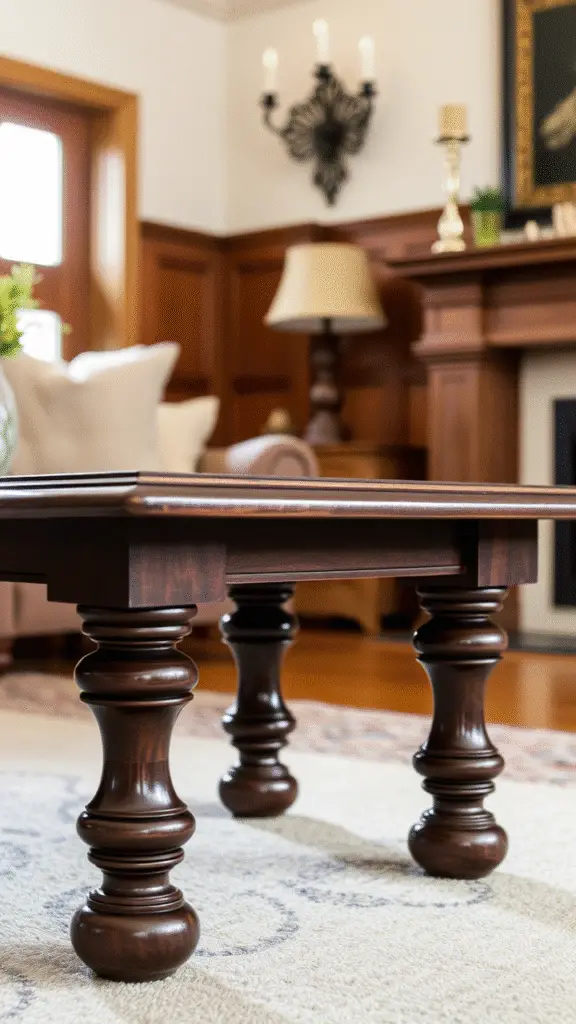
Classic wooden legs offer timeless versatility, crafted from woods like oak or walnut. Featuring turned, carved, or simple straight designs, they add warmth and suit traditional or rustic coffee tables, enhancing the living room’s classic appeal.
There’s an undeniable warmth and familiarity associated with wood. Classic wooden legs, often seen in styles like Queen Anne, Chippendale, or simple Shaker designs, bring a sense of history and craftsmanship. Turned legs, created on a lathe, feature rounded profiles that can range from simple tapers to intricate carvings. Straight, square legs offer a more robust, grounded look, perfect for farmhouse or craftsman styles. The choice of wood (like rich mahogany, sturdy oak, or warm cherry) and finish (stained, painted, or natural) further customizes the look. Reputable suppliers like Osborne Wood Products offer a vast selection for those looking to purchase high-quality wooden legs.
2. Hairpin Metal Legs

Hairpin metal legs provide a sleek, modern look popular in minimalist designs. Made from bent metal rods, they appear lightweight yet sturdy, ideal for live-edge slabs or industrial tables, especially in smaller living spaces needing an open feel.
Originating in the mid-20th century as a material-saving design, hairpin legs have enjoyed a massive resurgence. Typically formed from steel rods bent into a “V” or “U” shape, they offer remarkable strength with minimal visual clutter. This makes them perfect for showcasing unique tabletops, like rustic live-edge wood slabs, reclaimed lumber, or even concrete. They are incredibly versatile, fitting seamlessly into modern, industrial, Scandinavian, and even some bohemian aesthetics. Available in various heights, finishes (raw steel, black, white, gold, copper), and thicknesses (number of rods), they offer plenty of customization. Many online retailers specialize in these, making them easily accessible for DIY projects.
3. Mid-Century Modern Tapered Legs
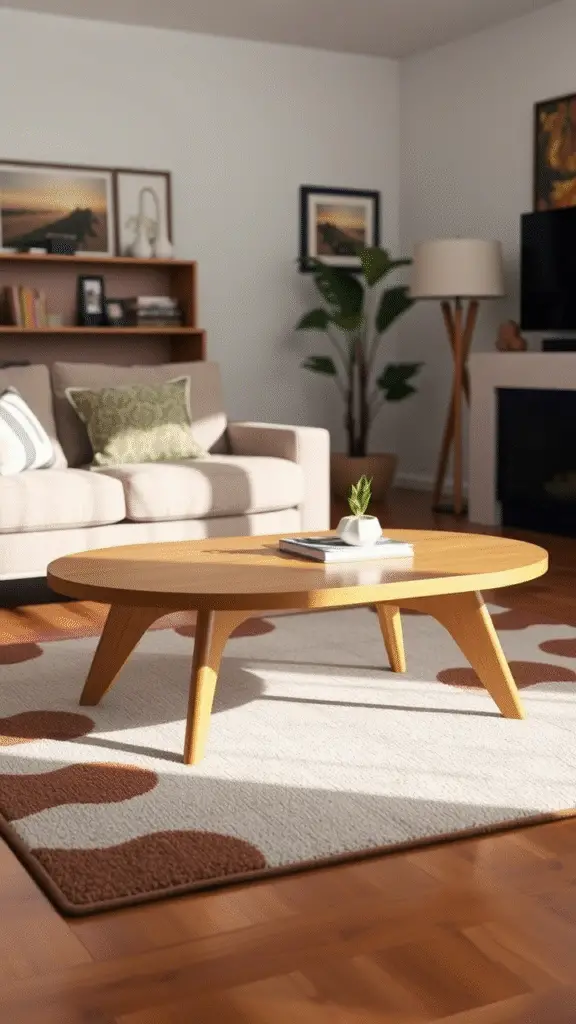
Mid-century modern tapered legs, often made from light woods like beech or ash, are a hallmark of retro design. They typically angle outward slightly, bringing vintage charm and working perfectly with boomerang or simple rectangular coffee table shapes.
Instantly recognizable, these legs define the iconic Mid-Century Modern (MCM) style (roughly 1945-1969). Characterized by their simple, elegant taper (narrowing towards the bottom) and often an outward splay, they create a sense of lightness and upward lift. Commonly crafted from woods like walnut, teak, beech, or ash, they pair beautifully with the clean lines and organic shapes typical of MCM furniture. Often featuring brass or metal ferrules (caps) at the bottom for a touch of polish, these legs add authentic vintage flair to kidney-bean, surfboard, or simple rectangular tabletops. Understanding the history of furniture design can provide context for this enduring style.
4. X-Shaped Metal Legs
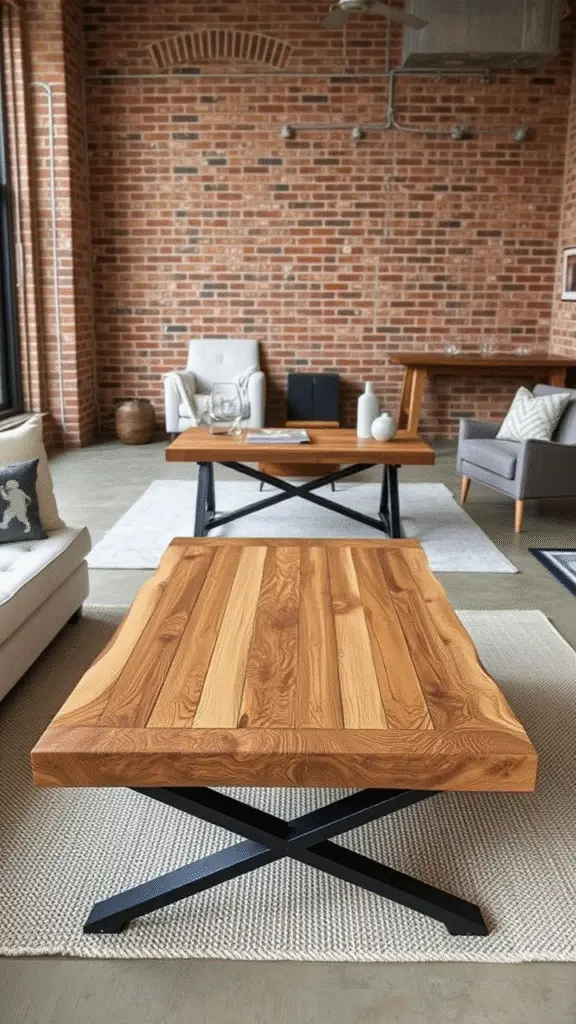
X-shaped metal legs offer a bold industrial aesthetic and provide excellent stability. Typically crafted from steel or iron with finishes like black powder-coating, they pair well with substantial rectangular or square tabletops for a striking centerpiece.
For a more robust and visually grounded look, X-shaped legs (also known as cross-legs) deliver significant impact. Constructed from metal tubing or flat bars, these legs provide exceptional support, making them ideal for heavy tabletops made from thick wood slabs, concrete, or stone. Their strong lines and often dark finishes (like matte black, gunmetal gray, or raw steel) lend themselves perfectly to industrial, rustic industrial, and modern farmhouse styles. They create a focal point and add a sense of architectural structure to the coffee table. Companies like Flowyline Design specialize in creating unique metal bases, including X-shapes.
5. Wishbone Metal Table Legs
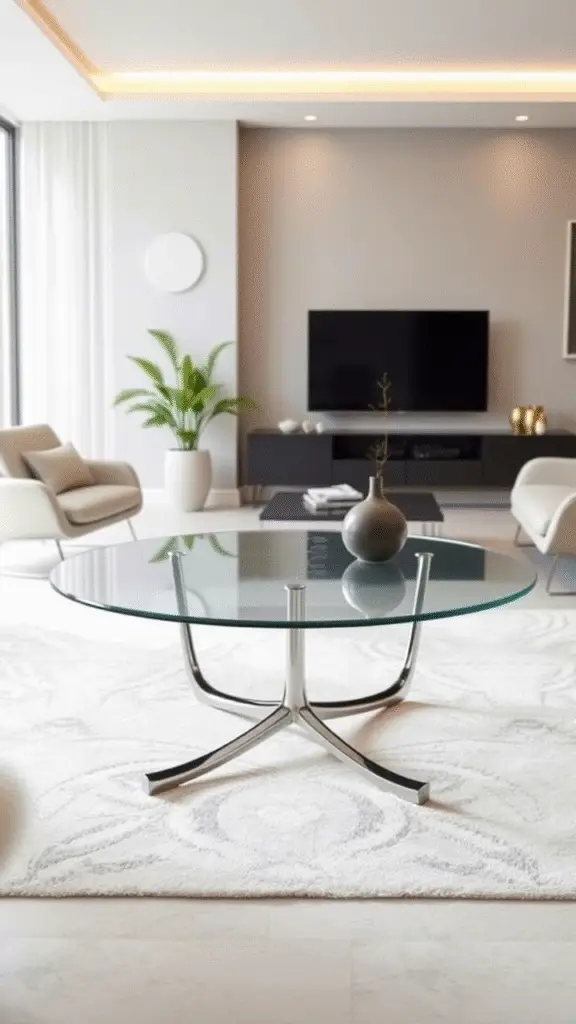
Wishbone-style metal legs are both functional and artistic, featuring curved “Y” shapes. They create an airy yet sturdy base perfect for round or oval coffee tables, adding elegance and a sculptural element to contemporary living rooms.
Offering a more organic and flowing alternative to straight metal legs, the wishbone or Y-leg design introduces graceful curves. Typically formed from metal, these legs split into two points of contact at the top (like a ‘Y’) and converge into a single point or a narrow base at the bottom. This creates a visually lighter, almost sculptural base that feels modern and sophisticated. They are particularly well-suited for round or oval tabletops, complementing the curves and providing stable support without appearing bulky. Finishes like chrome, brushed nickel, or gold can add a touch of glamour.
6. Geometric Metal Bases
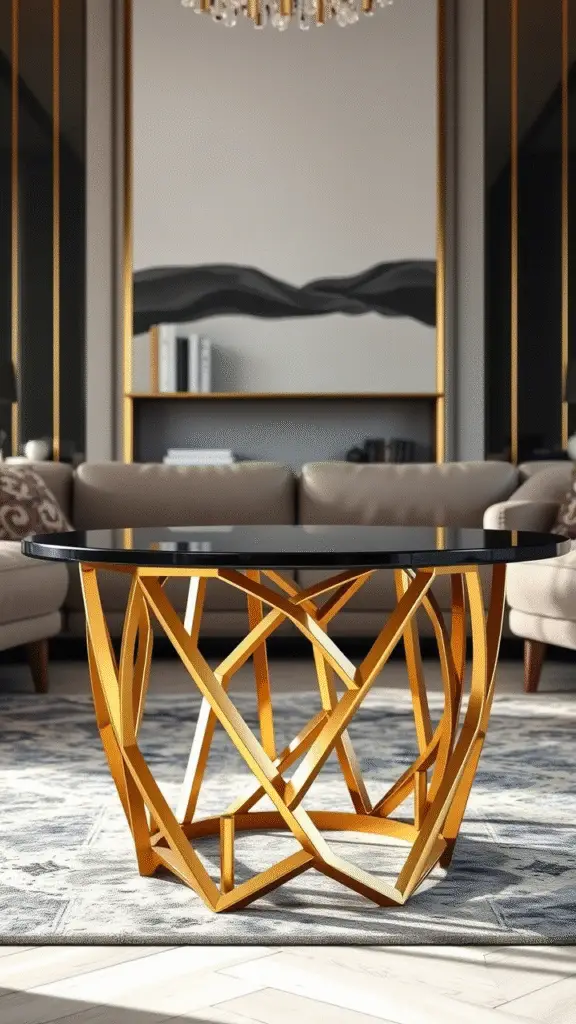
Geometric metal bases feature unique shapes like hexagons, triangles, cubes, or intricate interconnected lines. These designs make the coffee table a focal point in modern and contemporary living rooms, offering artistic flair while ensuring structural integrity under the tabletop.
Pushing the boundaries of traditional leg design, geometric bases transform the coffee table support into a work of art. Instead of individual legs, these often feature a single, complex structure crafted from metal bars or tubing. Think open cubes, interlocking triangles, faceted shapes, or abstract linear patterns. These bases demand attention and work best in minimalist or contemporary settings where they can be appreciated as sculptural elements. They pair well with simple glass, wood, or stone tops, allowing the base to be the star. Explore the Flowyline Design Blog for examples of such custom, artistic metal bases.
7. Live-Edge Wood Slab with Natural Stump Base
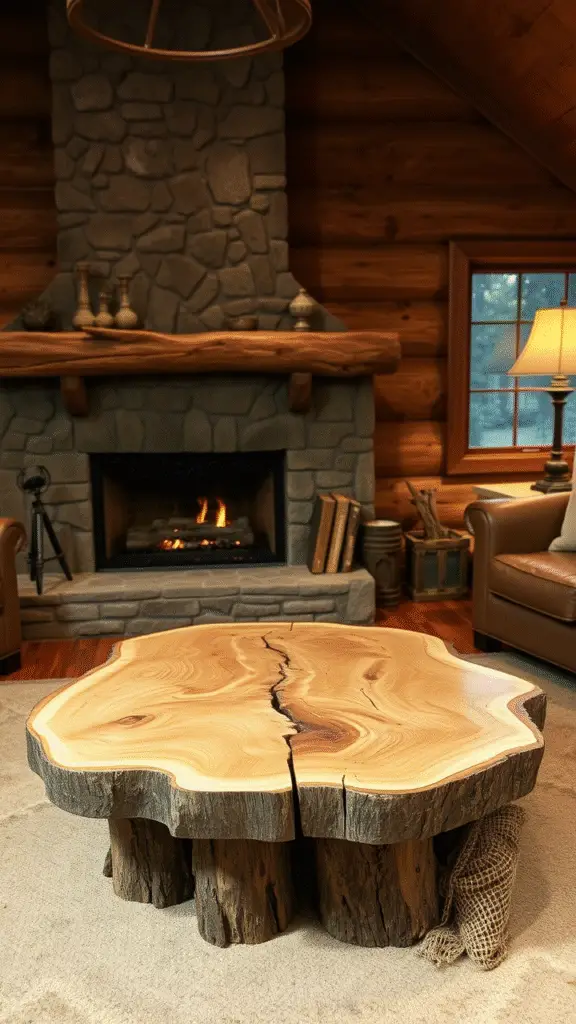
Pairing a live-edge wood slab with natural stump bases creates an earthy, rustic vibe. This organic aesthetic results in one-of-a-kind coffee tables due to the natural variations in wood grain, shape, and the unique character of each stump.
For the ultimate connection to nature, forget traditional legs altogether! Using sturdy, leveled tree stumps as a base for a beautiful live-edge wood slab creates a truly unique and organic coffee table. Each piece is inherently one-of-a-kind, showcasing the raw beauty of the wood’s grain, knots, and natural shape. This style is perfect for rustic, cabin, bohemian, or nature-inspired interiors. Finding suitable stumps and ensuring they are properly dried, treated, and leveled requires effort, but the result is a stunning conversation piece. Inspiration can often be found on platforms like Pinterest focusing on live edge furniture.
8. Cabriole Wooden Legs
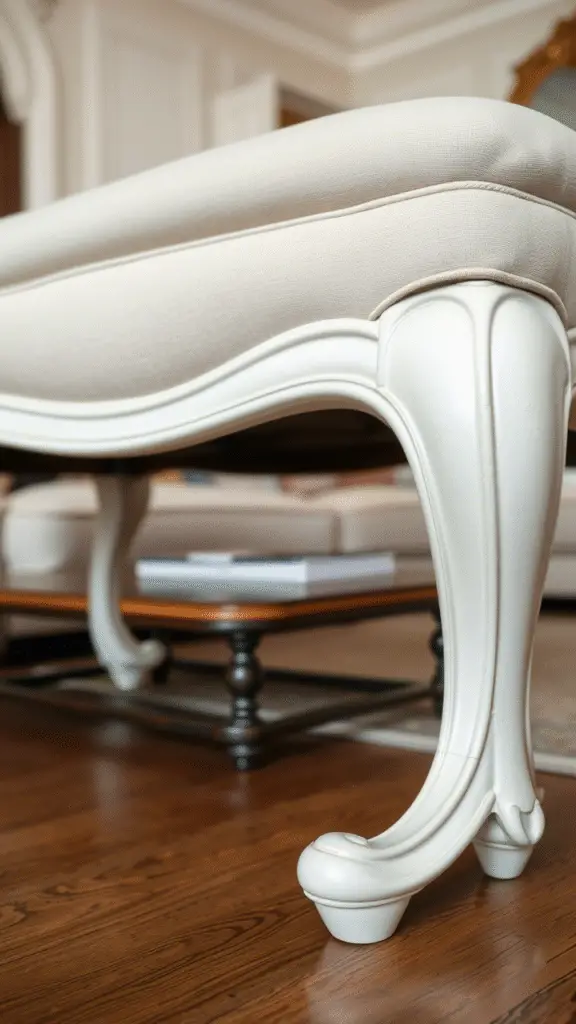
Cabriole legs feature elegant S-shaped curves, convex at the top and concave towards the bottom, often ending in decorative feet like pad or claw-and-ball styles. This design is perfect for traditional, French Provincial, or Rococo-inspired interiors, adding a touch of sophistication and refinement to the coffee table.
Originating in the early 18th century, the cabriole leg is synonymous with elegance and traditional European furniture styles like Queen Anne and Louis XV. Its distinctive double curve mimics the hind leg of a leaping animal (‘cabriole’ is French for ‘leap’). Often crafted from fine woods like walnut or mahogany, they can feature carved details at the ‘knee’ (the upper curve) and terminate in various decorative feet. This style adds undeniable grace and formality, pairing beautifully with traditionally shaped wooden or marble tabletops. They instantly elevate the sophistication level of any living room.
9. Spider-Style Metal Legs
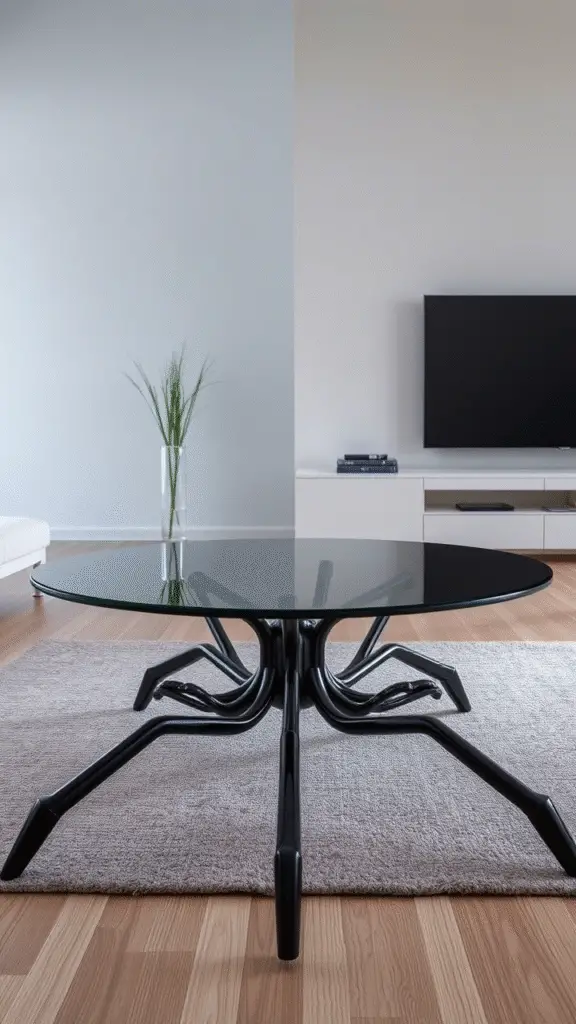
Spider-style metal legs radiate outward from a central hub, creating an eye-catching starburst effect beneath the table. This design works exceptionally well with round or square glass tabletops, enhancing modern or futuristic spaces with a unique structural element.
Similar to geometric bases but often with a more symmetrical, radiating pattern, spider legs offer a dynamic and modern look. Metal legs extend outwards from a central connection point, resembling the legs of a spider or a starburst. This creates a stable platform, especially suited for round or square tops where the legs can distribute weight evenly. The open design maintains a sense of space while providing a visually interesting structure. Black, chrome, or brass finishes are common, complementing contemporary, industrial, or even glam decor styles.
10. Floating Acrylic Bases
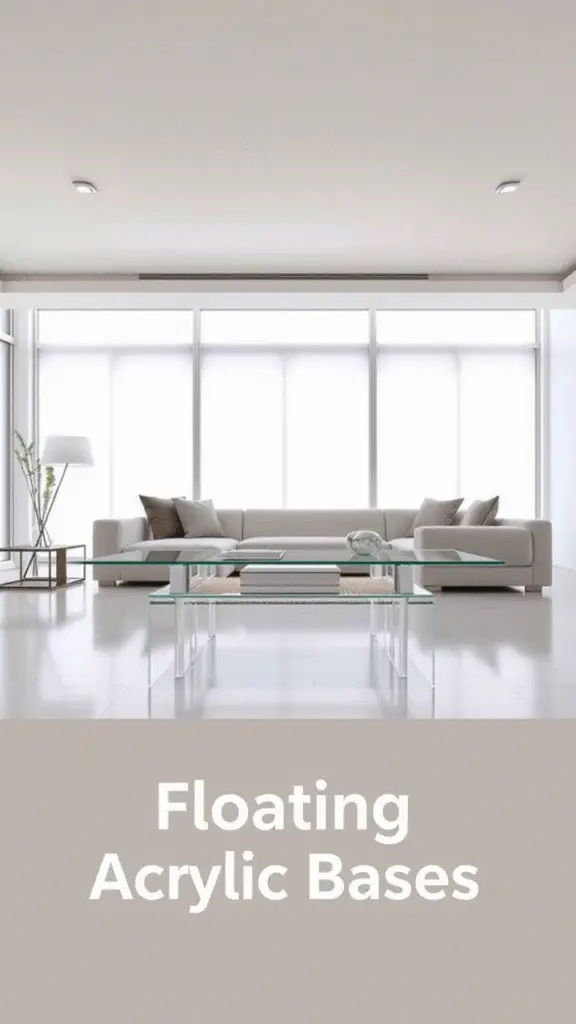
Acrylic or Lucite bases create a “floating” illusion by being nearly invisible. Ideal for small spaces or minimalist designs, these clear bases provide sturdy support while maintaining an open, airy feel, complementing glass or light-colored tabletops in modern interiors effectively.
Want the table to appear as if it’s hovering? Clear acrylic (often referred to by the brand name Lucite) legs or panel bases achieve just that. By minimizing the visual presence of the support structure, they make the tabletop the absolute star and enhance the feeling of spaciousness in a room. This makes them an excellent choice for smaller living areas or for rooms where you want other furniture pieces or rugs to remain visible. They pair exceptionally well with glass tops for a completely see-through effect or with solid tops for a striking contrast. While durable, acrylic can be prone to scratching, so careful use is advised. Many retailers selling acrylic furniture showcase this style.
11. Farmhouse Turned Wooden Legs
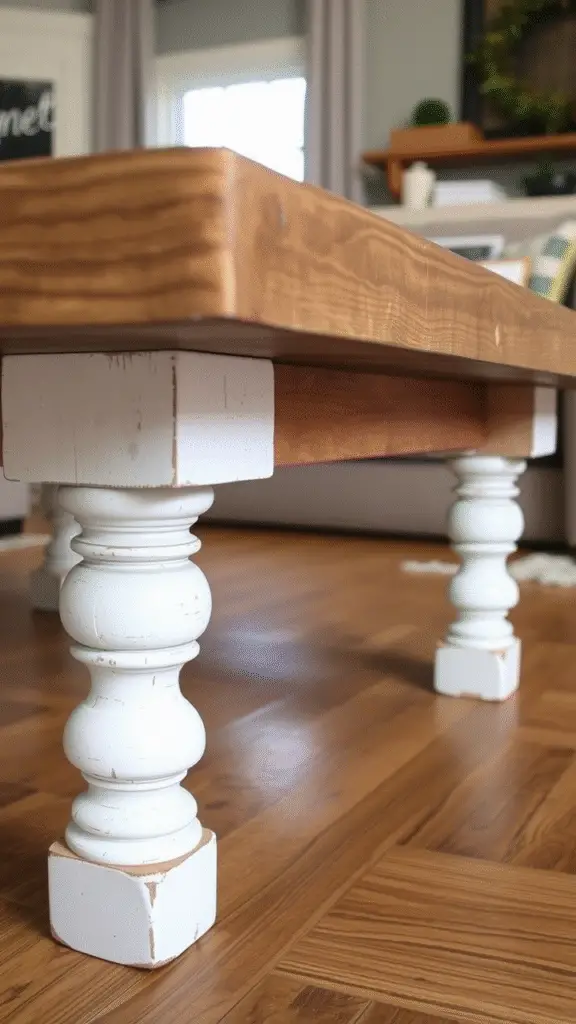
Farmhouse turned wooden legs feature substantial, rounded profiles created on a lathe, common in rustic and country furniture. Often chunky and simple, painted finishes like white or distressed gray enhance their country appeal, pairing beautifully with reclaimed wood tops for authentic farmhouse style.
Evoking a sense of warmth, comfort, and handcrafted charm, farmhouse-style turned legs are typically sturdier and less ornate than classic traditional turned legs. They often feature simple curves, balls, or ring details turned on a lathe. Pine or other readily available woods are common. What truly defines the farmhouse look is often the finish – painted (especially white, cream, or pale gray) and sometimes distressed to give a time-worn appearance. These legs are the perfect match for thick, planked, or reclaimed wood tabletops, creating the quintessential cozy farmhouse coffee table. Suppliers like Carolina Leg Co. specialize in this aesthetic.
How Do You Choose the Right Coffee Table Legs?
Choosing the right coffee table legs involves considering the tabletop’s size and weight, the desired style (modern, rustic, etc.), the appropriate height (typically 16-18 inches), and the material (wood, metal, acrylic) that best complements your existing living room decor and functional needs. It’s about balancing aesthetics, proportion, and practicality.
With so many fantastic options, how do you narrow it down? Selecting the perfect legs requires careful consideration of several factors to ensure your finished coffee table looks harmonious and functions well within your space. Let’s break down the key elements to ponder.
Matching Legs to Your Coffee Table Style
The most crucial step is ensuring the legs stylistically complement both the tabletop and your overall living room decor. A mismatch here can create a jarring effect. Think about the dominant style of your room and the tabletop itself.
- Modern/Minimalist: Hairpin legs, geometric bases, acrylic bases, simple metal legs (wishbone, spider).
- Mid-Century Modern: Tapered wooden legs (often angled), potentially hairpin legs.
- Industrial: X-shaped metal legs, hairpin legs, pipe legs (DIY), chunky square metal legs.
- Rustic/Farmhouse: Farmhouse turned legs, classic straight wooden legs, stump bases, X-shaped wooden legs, potentially chunky metal legs.
- Traditional/Classic: Cabriole legs, classic turned wooden legs, carved wooden legs.
- Bohemian: Natural stump bases, hairpin legs (especially with live-edge tops), perhaps some simpler wooden styles.
- Glam: Geometric bases (especially in gold or chrome), acrylic bases, potentially wishbone or spider legs in metallic finishes.
Consider the material of your tabletop too. Heavy slabs need robust support (like X-legs or substantial wooden legs), while lighter tops (like glass) can work well with more delicate designs (hairpin, acrylic). Harmonizing these elements is key to achieving a cohesive look, much like selecting the right coffee table accessories.
What is the Standard Height for Coffee Table Legs?
The standard height for coffee table legs is typically between 16 and 18 inches. The ideal height ensures the coffee table surface is level with or slightly lower (1-2 inches) than the seat cushions of your sofa for comfortable use and visual balance.
This height range allows for easy reach whether you’re placing down a drink or kicking up your feet. A table that’s too high or too low relative to your seating will look and feel awkward. Measure the height of your sofa cushions from the floor, then aim for legs (plus the thickness of your tabletop) that bring the final table height close to that measurement. Custom leg heights are often available if standard sizes don’t suit your specific sofa or desired look. Remember to factor in the thickness of your chosen tabletop when calculating the final height!
Considering Materials: Wood vs. Metal vs. Acrylic?
Each material brings its own set of aesthetic qualities, durability levels, and maintenance requirements.
- Wood:
- Pros: Offers natural warmth, vast style variety (turned, carved, straight), can be painted or stained, timeless appeal, suits many decor styles (traditional, rustic, farmhouse, MCM).
- Cons: Can be scratched or dented, may require sealing/refinishing, can feel visually heavier than metal or acrylic.
- Metal (Steel, Iron):
- Pros: Excellent durability and strength, sleek modern/industrial look, variety of shapes (hairpin, X-base, geometric), often powder-coated for protection, visually lighter than solid wood.
- Cons: Can feel cold, may rust if not properly finished (especially raw steel), style might not suit all decors.
- Acrylic (Lucite):
- Pros: Creates a “floating” invisible look, makes spaces feel larger, modern and sleek, lightweight appearance.
- Cons: Prone to scratching, can yellow over time with UV exposure (less common with quality acrylic), fingerprints show easily, primarily suits modern/glam styles.
Your choice depends on the look you want, the durability you need (consider kids or pets), and how the material interacts with your tabletop and existing furniture. Mixing materials, like a wood top with metal legs, is a very popular and effective strategy. Understanding how to style different table shapes, like exploring ideas for how to style a rectangular coffee table or how to style round coffee table, can also influence your leg choice.
Where Should You Place Legs on a Coffee Table for Stability?
For maximum stability, place coffee table legs near the corners of square or rectangular tops, typically inset slightly (1-3 inches from the edges). For round or irregularly shaped tables, position three or four legs equidistantly from the center and edge to ensure balanced support and prevent tipping or wobbling.
Proper leg placement is crucial not just for aesthetics but primarily for safety and stability. You don’t want your coffee table to wobble precariously or tip over easily.
- Rectangular/Square Tops: The most stable configuration is usually placing one leg near each corner. Setting them in slightly (1-3 inches) from the absolute edge often looks better aesthetically and provides excellent support. Avoid placing them too far inward, as this can cause the edges to sag or the table to become unstable if weight is placed near the perimeter.
- Round/Oval Tops: Three legs, placed in an equilateral triangle formation slightly in from the edge, provide surprisingly stable support and often a pleasing look (common in MCM designs). Four legs, placed equidistantly (like points on a compass), offer maximum stability, especially for larger or heavier round tops.
- Irregular/Live-Edge Tops: Assess the weight distribution and shape. You might need to adjust placement slightly from standard positions to ensure the heaviest parts are well-supported and the table balances correctly. Using a level during attachment is key.
Always consider the type of legs too. Wide bases like X-legs or geometric structures inherently offer more stability than very thin individual legs. If unsure, consulting a basic guide on furniture stability can be helpful.
Can You DIY Your Own Coffee Table Legs?
Yes, you can absolutely DIY coffee table legs using materials like wood (simple blocks, turned posts), metal pipes for an industrial look, or even repurposed items like crates or architectural salvage. DIY allows for custom sizes, unique designs, and significant cost savings, tailored perfectly to your table and decor.
Feeling creative? Making your own coffee table legs is a rewarding project that allows for complete customization. You’re not limited to commercially available options, and you can often save money while achieving a truly unique look. Whether you’re a seasoned woodworker or a beginner crafter, there are DIY leg ideas suitable for various skill levels.
Simple DIY Wooden Leg Ideas
Even with basic tools and skills, you can craft functional and stylish wooden legs.
- Block Legs: Cut simple blocks from sturdy lumber like 4×4 posts. Sand them smooth and attach directly to the underside of the tabletop for a minimalist, chunky look.
- Tapered Legs (Simple Jig): With a table saw or even a hand saw and a simple tapering jig (many tutorials online), you can create basic tapered legs from square stock (like 2x2s).
- Layered Plywood Legs: Cut identical shapes (e.g., simple rectangles or slightly curved forms) from multiple sheets of plywood. Glue and clamp them together to create thick, sturdy legs with interesting layered edges.
- Pre-made Components: Use readily available wooden components like fence post caps, stair balusters, or pre-turned furniture feet from hardware stores as your legs.
Remember to properly sand, finish (paint, stain, seal), and securely attach your DIY wooden legs using appropriate hardware like mounting plates or pocket holes. A basic woodworking tutorial can guide you on attachment methods.
Creative Ideas Using Unconventional Materials
Think outside the box for truly unique coffee table legs!
- Industrial Pipe Legs: Assemble standard plumbing pipes and fittings (galvanized or black iron) into various configurations (H-shape, square base, individual legs) for an instant industrial vibe. Clean and seal the pipes to prevent rust and grime.
- Cinder Blocks: Surprisingly chic in minimalist or industrial settings! Use standard cinder blocks (painted or left raw) as sturdy, inexpensive bases.
- Stacked Books (Reinforced): For a whimsical, literary look, carefully stack sturdy hardcover books. You’ll need to reinforce them internally (e.g., drilling through and using a threaded rod) and securely attach them to the tabletop and a base plate for stability.
- Wooden Crates: Sturdy wooden crates, stood on their ends, can serve as rustic or farmhouse-style legs with built-in storage. Ensure they are strong enough to support the tabletop.
- Architectural Salvage: Corbels, old posts, or other interesting structural elements found at salvage yards can be repurposed into unique and characterful legs.
- Hairpin Legs (DIY Jig): For the ambitious DIYer, jigs can be made to bend your own metal rods into hairpin shapes, although purchasing them is often easier and ensures consistency.
Exploring Pinterest boards dedicated to creative DIY furniture can spark endless inspiration for unconventional leg ideas.
FAQs About Coffee Table Legs Ideas
Got more questions? Here are answers to some frequently asked questions about coffee table legs:
What can I use instead of table legs?
You can use solid bases like drums or cubes, natural elements like tree stumps or large rocks (if stable), repurposed items like crates or vintage suitcases (stacked), or even create a floating effect by mounting the tabletop securely to a wall (for smaller tables). Geometric metal structures or solid panel bases (wood, acrylic) also function as alternatives to individual legs.
How big should coffee table legs be?
Coffee table legs, combined with the tabletop thickness, should typically result in a table height between 16-18 inches, roughly level with or slightly below your sofa cushions. The visual “bigness” or thickness depends on the style – chunky legs for rustic/industrial, slender legs for modern/MCM. Proportion to the tabletop size is key; large tops need visually and structurally substantial legs.
Where should legs be placed on a coffee table for maximum stability?
For rectangular/square tops, place legs near the corners, inset 1-3 inches. For round/oval tops, use three legs in an equilateral triangle or four legs equidistantly, set slightly in from the edge. This ensures balanced weight distribution and prevents tipping.
What is the rule of thumb for table legs regarding proportion and style?
The primary rule is visual balance and stylistic harmony. Legs should look proportional to the tabletop’s size and visual weight (heavy tops need sturdy-looking legs). The style of the legs should complement both the tabletop and the overall room decor. Ensure the final table height aligns correctly with surrounding seating (16-18 inches total height is standard).
What are the most popular materials for modern coffee table legs?
Metal (especially steel in black, brass, or chrome finishes) and acrylic (clear Lucite) are the most popular materials for modern coffee table legs. Metal offers sleek lines in designs like hairpin, geometric, spider, or wishbone legs. Acrylic provides a minimalist, “floating” look favored in contemporary spaces. Light-toned woods like ash or beech are also used, particularly for Mid-Century Modern styles.
Summary: Elevate Your Living Room with the Perfect Legs
Choosing the right coffee table legs is far more than a minor detail; it’s a powerful design decision that significantly impacts the look, feel, and functionality of your living room. From the timeless warmth of classic wood to the sleek edge of modern metal or the unique charm of DIY creations, the possibilities are vast.
By considering your room’s style, the tabletop’s characteristics, appropriate height, material properties, and stability needs, you can select or create legs that transform your coffee table from a mere surface into a true statement piece. Don’t underestimate the power of those supports – the perfect legs are waiting to elevate your space. Remember that thoughtful details, like the right coffee table decor, complete the picture, working in harmony with your chosen leg style.

